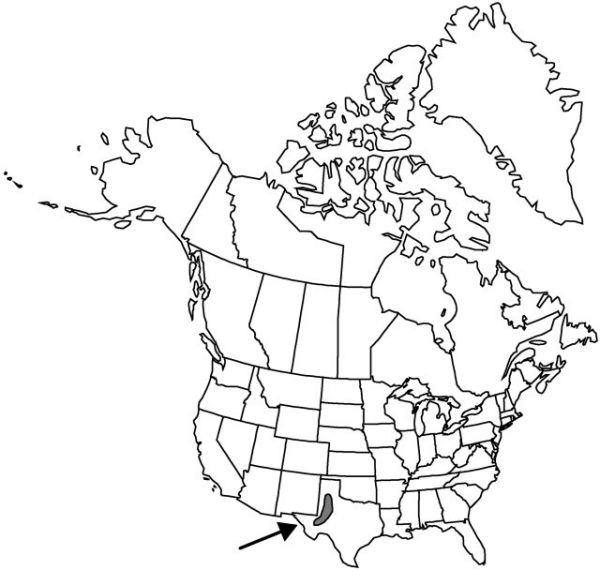Difference between revisions of "Yucca campestris"
Yuccas Southw. U.S. 2: 173, plates 62, 63. 1947.
FNA>Volume Importer |
imported>Volume Importer |
||
| (6 intermediate revisions by 2 users not shown) | |||
| Line 8: | Line 8: | ||
}} | }} | ||
|common_names=Plains yucca | |common_names=Plains yucca | ||
| + | |special_status={{Treatment/ID/Special_status | ||
| + | |code=E | ||
| + | |label=Endemic | ||
| + | }} | ||
|basionyms= | |basionyms= | ||
|synonyms= | |synonyms= | ||
| Line 24: | Line 28: | ||
|elevation=800–900 m | |elevation=800–900 m | ||
|distribution=Tex. | |distribution=Tex. | ||
| − | |discussion=<p>Yucca campestris is endemic to the plains region in the southern panhandle counties of western Texas. S. D. McKelvey (1938–1947) discussed its variation in relation to its distribution, and K. H. Clary’s (1997) DNA studies support its recognition as a distinct species. J. M. Webber (1953) considered Y. campestris to be a hybrid between Y. constricta and Y. elata, and reported a distribution from west Texas into southern New Mexico, and possibly into northwestern New Mexico. Additional study within these regions may help resolve the relationships and origin of this species.</p> | + | |discussion=<p><i>Yucca campestris</i> is endemic to the plains region in the southern panhandle counties of western Texas. S. D. McKelvey (1938–1947) discussed its variation in relation to its distribution, and K. H. Clary’s (1997) DNA studies support its recognition as a distinct species. J. M. Webber (1953) considered <i>Y. campestris</i> to be a hybrid between <i>Y. constricta</i> and <i>Y. elata</i>, and reported a distribution from west Texas into southern New Mexico, and possibly into northwestern New Mexico. Additional study within these regions may help resolve the relationships and origin of this species.</p> |
|tables= | |tables= | ||
|references= | |references= | ||
| Line 33: | Line 37: | ||
-->{{#Taxon: | -->{{#Taxon: | ||
name=Yucca campestris | name=Yucca campestris | ||
| − | |||
|authority=McKelvey | |authority=McKelvey | ||
|rank=species | |rank=species | ||
| Line 47: | Line 50: | ||
|publication title=Yuccas Southw. U.S. | |publication title=Yuccas Southw. U.S. | ||
|publication year=1947 | |publication year=1947 | ||
| − | |special status= | + | |special status=Endemic |
| − | |source xml=https:// | + | |source xml=https://bitbucket.org/aafc-mbb/fna-data-curation/src/2e0870ddd59836b60bcf96646a41e87ea5a5943a/coarse_grained_fna_xml/V26/V26_908.xml |
|genus=Yucca | |genus=Yucca | ||
|species=Yucca campestris | |species=Yucca campestris | ||
Latest revision as of 22:18, 5 November 2020
Plants forming small or large, open colonies, acaulescent or occasionally caulescent and arborescent, rhizomatous; rosettes usually small. Stems 0.6–1 m. Leaf blade linear, plano-convex or plano-keeled, widest near middle, 40–65 × 0.3–0.7(–1.5) cm, rigid, margins entire, filiferous, white, apex spinose, spine acicular, 7 mm. Inflorescences paniculate, arising within or occasionally beyond rosettes, narrowly ellipsoid, 6–10 dm, distance from leaf tips to proximal inflorescence branches less than twice leaf length when fully expanded, glabrous; branches to 13 cm; bracts erect; peduncle scapelike, 0.5–1 m, less than 2.5 cm diam. Flowers pendent; perianth globose; tepals connate, dull green, sometimes tinged pink, 4.1–6.5 × 1.5–2.5 cm; filaments shorter than pistil, flaccid; anthers 3.2 mm; pistil ovoid to obovoid, 2.5–3 × 0.5–0.9 cm; style bright green; stigmas lobed. Fruits erect, capsular, dehiscent, symmetrical or rarely constricted, 4.5–5.5(–6.3) × 3–5 cm, dehiscence septicidal. Seeds glossy black, thin, 11–14 × 8–11 mm.
Phenology: Flowering spring.
Habitat: Deep sands
Elevation: 800–900 m
Discussion
Yucca campestris is endemic to the plains region in the southern panhandle counties of western Texas. S. D. McKelvey (1938–1947) discussed its variation in relation to its distribution, and K. H. Clary’s (1997) DNA studies support its recognition as a distinct species. J. M. Webber (1953) considered Y. campestris to be a hybrid between Y. constricta and Y. elata, and reported a distribution from west Texas into southern New Mexico, and possibly into northwestern New Mexico. Additional study within these regions may help resolve the relationships and origin of this species.
Selected References
None.
